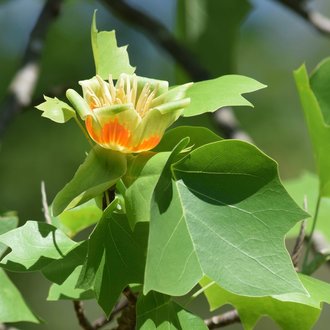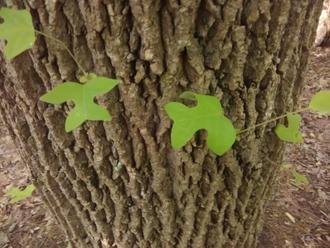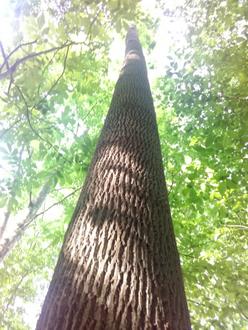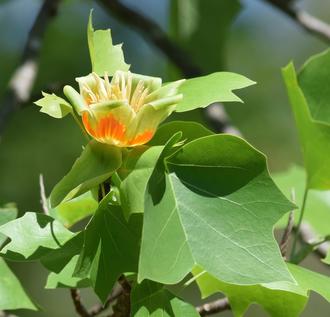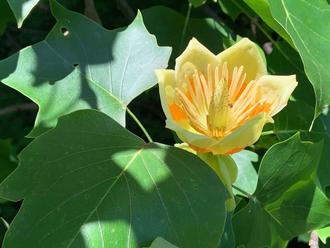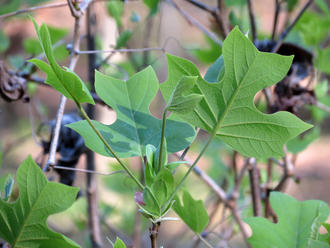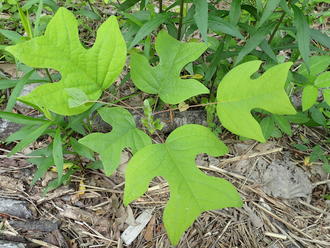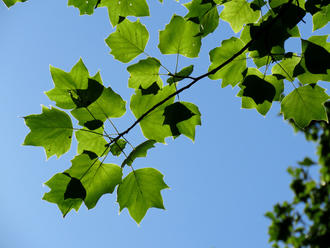American Tuliptree (Liriodendron tulipifera L.)
Also known as tulip tree, American tulip tree, tulipwood, tuliptree, tulip poplar, whitewood, fiddletree, yellow poplar, yellow-poplar.
↑Summary
A large deciduous tree native to eastern North America, with distinctive four-lobed leaves and tulip-like blossoms.
↑Range - Expand
| Legend | Color |
| Native | |
| Expanded or Not Present | |
| Native or Expanded or Not Present | |
| Native or Expanded | |
| Expanded | |
| Native or Not Present |
This map is based on our research. We have checked its accuracy to Level 3 ecoregions. Although this plant occurs somewhere in each of these regions, it may only occur in a small part of some or all of them.
BONAP reports this species as adventive in Iowa and Texas, whereas many other sources consider it native. We accept BONAP's classification, and mark these regions as expanded because, even if these populations may result from escapes of landscaping plants, they are adjacent to this species native range.
↑Habitat
Found in hardwood and mixed forests, and early-successional stages of recently cleared forests or abandoned fields. Grows best on cooler north- and east-facing slopes, sheltered coves, lower slopes and concave slopes, but can be found on a wide range of sites. Best growth is on deep, moist, well-drained, loose-textured soils rich in organic matter, but also grows in silty soils and can tolerate clay soil if well-drained. In most of its range, can tolerate pH down to 4.5. Found in a wide range of climactic conditions.
In most of its range, intolerant of flooding, but some trees in the southeast of this species range are able to tolerate flooding and consistently wet conditions, and these trees can be found in floodplains and along rivers and streams. These trees have different genetics and are also much more tolerant of water-saturated organic soils, and acidic soil with pH below 4.0.
Establishes primarily as a pioneer species, but persists in mid-successional stages due to its large maximum height, which enables it to keep reaching the high-light conditions it needs, even when shade-tolerant species establish underneath it. Often, scattered individuals remain in old-growth forests. The species can persist long-term in forests with enough local disturbance to allow it to colonize gaps.
Found from sea level to 4,500 ft (1,364 m). Found in areas that experience no fire, or infrequent fire of light to moderate severity, but absent from ones that burn regularly, as regular fire prevents trees from reaching maturity. Often establishes on sites that have burned recently.
↑Life Cycle
Seeds germinate on the surface of the soil, primarily on exposed mineral soil or decomposed humus. Seedlings have high light requirements and survival is poor in shade, although seedlings can sometimes establish in gaps under a thin forest canopy.
Growth is rapid in good conditions; trees may flower and produce seed as early as 10 years, but most commonly begin producing seed at 15-20 years of age. Seed production continues for 200 years or more. Seed production is large, but seeds have a low (5-20%) proportion of viability. Seeds remain viable in the seed bank for up to 8 years. Germination is in response to sun and heat, but is enhanced by repeated periods of cold dormancy.
Mature trees are highly resistant to low-to-moderate intensity fires, often more resistant than oaks. Trees are unlikely to be wounded by such fires. The absence of low branches also prevents ground fires from reaching the canopy. However, saplings are vulnerable to fire and are often killed by fires. As such, tuliptree benefits from fire regimes where low-to-moderate intensity fires happen at intervals long enough to allow its establishment and growth to a large enough size for it to develop insulated bark.
↑Faunal Associations
Tuliptree is browsed by deer year-round, which eat the foliage when available and also the twigs.
The flowers are primarily insect-pollinated, attracting various beetles, flies, and long-tongued bees including honeybees, bumblebees, and others. Hummingbirds also sometimes visit the flowers.
The seeds are eaten by birds, including northern bobwhite, purple finch, northern cardinal, American goldfinch, and Carolina chickadee, and also by small mammals including squirrels and mice. The yellow-bellied sapsucker also consumes the sap of this species, and eats insects attracted to or stuck in the sap; hummingbirds occasionally drink the sap produced by these holes as well.
Pileated woodpeckers often use this tree as a nesting site; it is attractive to this large woodpecker due to its large size.
Numerous insects eat this tree, including some that specialize on this species, like the Tuliptree scale (Toumeyella liriodendri) and Yellow-poplar weevil (Odontopus calceatus), a leaf-mining weevil, and the root collar borer moth (Euzophera ostricolorella). These insects mostly prefer this tree but some also eat other, mostly related species. The Columbian timber beetle Corthylus columbianus also eats the wood of this species. Together, these four insects can cause significant damage, and sometimes mortality, to trees.
Other insects that eat this tree but do not damage it as much include the tuliptree silkmoth (Callosamia angulifera), promethea silkmoth (Callosamia promethea), the tulip-tree beauty (Epimecis hortaria), and the eastern tiger swallowtail (Papilio glaucus).
↑Uses
The wood of this species is valuable, in large part because of its large size, rapid growth, and the straight, single-trunk growth habit. The wood is very easy to work with, but soft and prone to leaving fuzzy surfaces when sanded or cut. It is one of the most widely available and inexpensive hardwoods in the US. It was historically used by Native Americans for canoes. Nowadays it is used mainly where appearance is less important, including in pallets, crates, upholstered furniture frames, as pulpwood for paper, or for plywood. It is sometimes dyed and used in veneer, or put on the less-visible underside of veneer.
Tuliptree is often used as a landscaping plant, as a large shade tree, where it is valued for its rapid growth, ease of transplanting, distinctive leaf shape and attractive flowers. Its use in landscaping is limited by its large size, and its sensitivity to ground-level ozone which can stress trees in urban areas.
The nectar of its flowers can be used for making honey; the honey produced is a dark color. (source) It is commercially important as a honey plant in the southeastern U.S.
↑Related Plants
Tuliptree is the only tree of its genus found in North America, but there is another species, Liriodendron chinense, native to China.
There are numerous other species in North America in the broader Magnoliaceae family, mostly native and a few introduced, but none are closely related; tuliptree comes from a separate lineage that broke off from other members of that family rather early.
↑Notes
The growth of this species in sunny habitats is often severely stunted by vine growth. In more intact natural habitats, native grapes (Vitis sp.) are the main species affecting tuliptree. In some regions, however, invasive vines including japanese honeysuckle (Lonicera japonica), kudzu (Pueraria montana), or both native or introduced bittersweet (Celastrus sp.) can also hinder its growth. The vines can directly compete with trees for light, and can also weight the tree down, distorting its growth, which can affect its long-term viability. Such damage is most common in regions that have been clearcut.
↑Links & External Resources
• Poplar | The Wood Database (About This Site)
• Tuliptree | Fire Effects Information System (FEIS) (About This Site)
• Liriodendron tulipifera (Tulip Tree) | Illinois Wildflowers (About This Site)
• Liriodendron tulipifera (Tuliptree) | USDA PLANTS Database (About This Site)
• Liriodendron tulipifera | Go Botany (About This Site)
• Liriodendron tulipifera (Tulip Tree) | Missouri Botanical Garden Plant Finder (About This Site)
• Yellow-Poplar | Virginia Tech Dendrology Factsheets (About This Site)
• Yellow-Poplar | Silvics of North America (About This Site)
• Liriodendron tulipifera | Biota of North America Project (BONAP) (About This Site)
• Liriodendron tulipifera | NatureServe Explorer (About This Site)
• Liriodendron tulipifera | Flora of North America (About This Site)
• Liriodendron tulipifera | Missouri Plants (About This Site)
• Tulip Poplar | Maryland Biodiversity Project (About This Site)
• Liriodendron tulipifera L. (Tulip-Poplar, Yellow Poplar, Tuliptree) | Digital Atlas of the Virginia Flora (About This Site)



